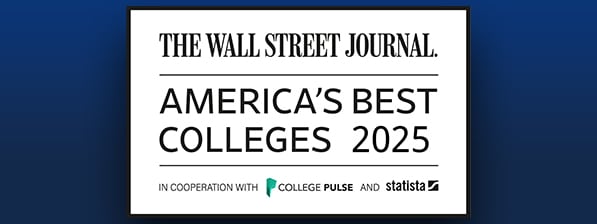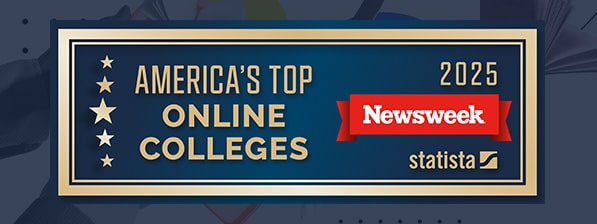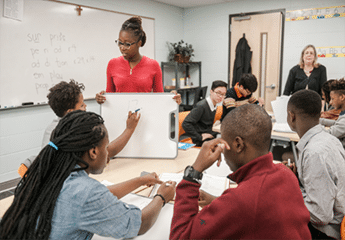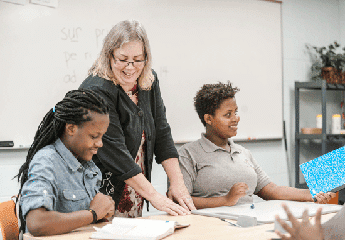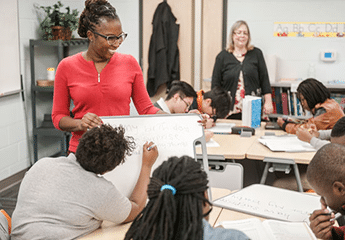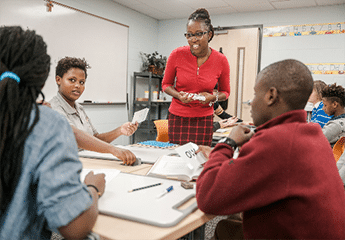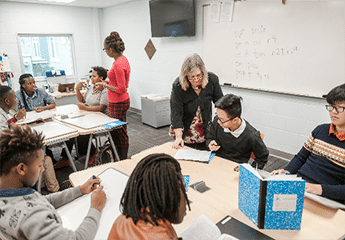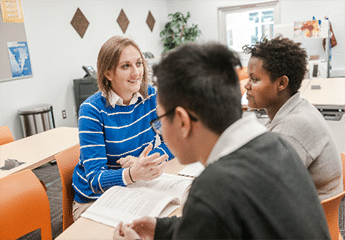
Over the past few decades, research in the field of learning has led to the discovery of the Theory of Multiple Intelligences. In short, this theory states that each person has different ways of learning and different intelligences they use in their daily lives.
While some can learn very well in a linguistically-based environment (reading and writing), others are better taught through mathematical-logic based learning. Still others benefit most from body-kinesthetic intelligence (learning by doing with the hands).
Each person possesses each intelligence to an extent, but there is always a primary, or more dominant, intelligence.
The work on multiple intelligences began in the early 1980s with Howard Gardner, and the research continues.
Howard Gardner’s Theory of Multiple Intelligence
Howard Gardner of Harvard University originally identified seven distinct intelligences. According to Gardner, this theory, which emerged from cognitive research, “documents the extent to which students possess different kinds of minds and therefore learn, remember, perform, and understand in different ways.”
In greater detail, the theory proposes that “we are all able to know the world through language, logical-mathematical analysis, spatial representation, musical thinking, the use of the body to solve problems or to make things, an understanding of other individuals and an understanding of ourselves. Where individuals differ is in the strength of these intelligences and the ways in which such intelligences are invoked and combined to carry out different tasks, solve diverse problems and progress in various domains.” Hani Morgan (2014) supports Gardner’s theory. Morgan’s research indicated that differentiated instruction benefits all students, but must be presented by well-prepared, experienced and knowledgeable teachers.
This diversity, according to Gardner, should impact the way people are educated. He stated that these differences “challenge an educational system that assumes that everyone can learn the same materials in the same way and that a uniform, universal measure suffices to test student learning.” Joan Hanifin, an Irish researcher, determined in a 2014 publication that the outdated system of education in Ireland was adversely affecting students in the long-term. By not embracing multiple methods of teaching based on different intelligences, students often left school feeling “under-valued.”
Gardner goes on to say that, “Indeed, as currently constituted, our educational system is heavily biased toward linguistic modes of instruction and assessment and, to a somewhat lesser degree, toward logical-quantitative modes as well.”
Gardner argues that “a contrasting set of assumptions is more likely to be educationally effective. Students learn in ways that are identifiably distinctive. The broad spectrum of students—and perhaps the society as a whole—would be better served if disciplines could be presented in a number of ways and learning could be assessed through a variety of means.” In 2010, Bas and Beyhan presented findings based on their study of using Multiple Intelligences theory in learning English. They determined that MI-based learning is more effective in terms of student achievement levels and their attitudes toward learning. Their research supports Gardner’s assertion that MI-based learning will serve students well.
The 9 Multiple Intelligences
Gardner claims that all human beings have multiple intelligences. These multiple intelligences can be nurtured and strengthened or ignored and weakened. His research from 1991 identified seven intelligences; in the intervening time, he has come to believe there are a total of nine intelligences:
- Verbal-Linguistic Intelligence: Well-developed verbal skills and sensitivity to the sounds, meanings and rhythms of words.
- Mathematical-Logical Intelligence: The ability to think conceptually and abstractly, and the capacity to discern logical or numerical patterns.
- Musical Intelligence: The ability to produce and appreciate rhythm, pitch and timbre.
- Visual-Spatial Intelligence: The capacity to think in images and pictures, to visualize accurately and abstractly.
- Bodily-Kinesthetic Intelligence: The ability to control one’s body movements and to handle objects skillfully.
- Interpersonal Intelligence: The capacity to detect and respond appropriately to the moods, motivations and desires of others.
- Intrapersonal Intelligence: The capacity to be self-aware and in tune with inner feelings, values, beliefs and thinking processes.
- Naturalist Intelligence: The ability to recognize and categorize plants, animals and other objects in nature.
- Existential Intelligence: The sensitivity and capacity to tackle deep questions about human existence, such as the meaning of life, why we die and how we got here.
While all people possess some level of each intelligence, most will experience more dominant intelligences that impact the way they learn and interact with the world around them.
Multiple Intelligences and Learning Styles
Some may find it an impossible task to teach to all learning styles. However, teachers are using multimedia, so it is becoming easier. As teachers begin to understand learning styles more effectively, it is clear why multimedia is good for all learners and why a variety of media is more effective. Multimedia inherently speaks to the different types of learning preferences that one person has and has the potential to impart knowledge to a diverse class or group.
There are specific modes of multimedia and instruction techniques, which include the following:
- Visuals: Visual media help students acquire concrete concepts, such as object identification, spatial relationship or motor skills.
- Printed words: While the printed word is the most common method of dispensing information, some argue that audio is superior.
- Sound: Sound media offer a stimulus for sound recognition or recall. Audio narration is a useful tool for students who struggle with reading.
- Motion: Motion depicts human performance so that learners can copy the movement. This kinesthetic method can be essential for understanding some subject matter.
- Color: Choices on color display are required if it is essential to what is being learned (such as, the sky is blue).
- Realia: Realia teaches cognitive and motor skills with objects. Realia can be used with individuals or groups, depending on the situation. Realia may be used to present information realistically, or with the way learners internalize information.
- Instructional Setting: Design must include what materials are being used, as well as the environment in which it is to be taught. Printed materials should be individualized to allow the learner to set the pace.
- Learner Characteristics: Teaching models must consider learner characteristics, as media may be interpreted in various ways by different learners. Research has not provided definitive methods in matching the media most suitable for types of learners.
- Reading Ability: Pictures aid learning for poor readers who understand spoken words rather than printed words; good readers can control the pace, and print allows for easier review.
- Categories of Learning Outcomes: Categories ranged from three to eleven and most include some or all of Gagne’s (1977) learning categories: intellectual skills, motor skills, verbal information, overall attitudes and use of cognitive strategies.
- Events of Instruction: Teachers have to choose the external events which support internal learning with events of instruction. This occurs in the planning stage and before selection of appropriate media.
- Performance: It is important for students to perform tasks that demonstrate learning and retention. The elicited performances can be categorized by type: covert, overt, motor, verbal, constructed and select. Media should be selected to correspond with the desired outcome.
Multiple Intelligences in the Classroom
Educators have positively responded to Gardner’s theory. It has been embraced by a range of educational theorists and, significantly, applied by teachers and policymakers to the problems of schooling.
Many schools in North America have sought to structure curricula according to the intelligences and to design classrooms—even whole schools—to reflect the understandings that Howard Gardner develops.
All intelligences are needed to live life well. Teachers, therefore, need to attend to all intelligences, not just the first two of verbal-linguistic or mathematical-logical intelligences, which have historically taken precedence.
Multiple Intelligence Activities
One of the most significant results of the theory of multiple intelligences is how it has provided eight different potential pathways to learning. If a teacher is having difficulty reaching a student in the more traditional linguistic or logical ways of instruction, the theory of multiple intelligences suggests several other ways in which the material might be presented to facilitate effective learning:
- Words (linguistic intelligence).
- Numbers or logic (logical-mathematical intelligence).
- Pictures (spatial intelligence).
- Music (musical intelligence).
- Self-reflection (intrapersonal intelligence).
- A physical experience (bodily-kinesthetic intelligence).
- A social experience (interpersonal intelligence).
- An experience in the natural world (naturalist intelligence).
You don’t have to teach or learn something in all eight ways. However, simply knowing the possibilities available can enable you to decide which particular pathways interest you the most or seem to be the most effective teaching or learning tools.
The theory of multiple intelligences is so intriguing because it expands our horizon of available teaching and learning tools beyond the conventional linguistic and logical methods used in most schools (e.g. lecture, textbooks, writing assignments, formulas, etc.).
Multiple Intelligences: New Horizons
Having an understanding of different teaching approaches from which we all can learn, as well as a toolbox with a variety of ways to present content to students, is valuable for increasing the accessibility of learning experiences for all students.
We want to continue to develop this toolbox, so it is especially important to gather ongoing information about student strengths and challenges, as well as their developing interests and dislikes. Providing different learning contexts for students and engaging a variety of their senses is supported by current research. Studies done by Hamari et al (2016) suggest that engaging in learning games has a positive effect on learning: “. . . educational video games may be an effective means of posing learning challenges that are perceived as interesting and enjoyable, resulting in engagement and immersion in the game-based learning task.”
As our insatiable curiosity about the learning process persists and studies continue to evolve, additional scientific research may emerge that further elaborates on multiple intelligences and learning styles.
How Do We Benefit from Understanding Multiple Intelligences?
When educators are given the freedom to move away from the traditional, visually-based methods of teaching, they will have the opportunity to reach more students, more effectively. By teaching to the dominant learning intelligences, teachers will find students to be more productive, more receptive and more willing to engage in the learning process.
As so many educators have already embraced this theory, it is time for educational administrators to take notice of new techniques that can be successful based on the research of Howard Gardner and the other researchers who have followed.
Identify the Intelligences in Your Classroom
Understanding and adapting your teaching style to your students can help everyone succeed. Our Master of Arts in Education degree program incorporates courses where you can identify and build upon such multiple intelligences.
